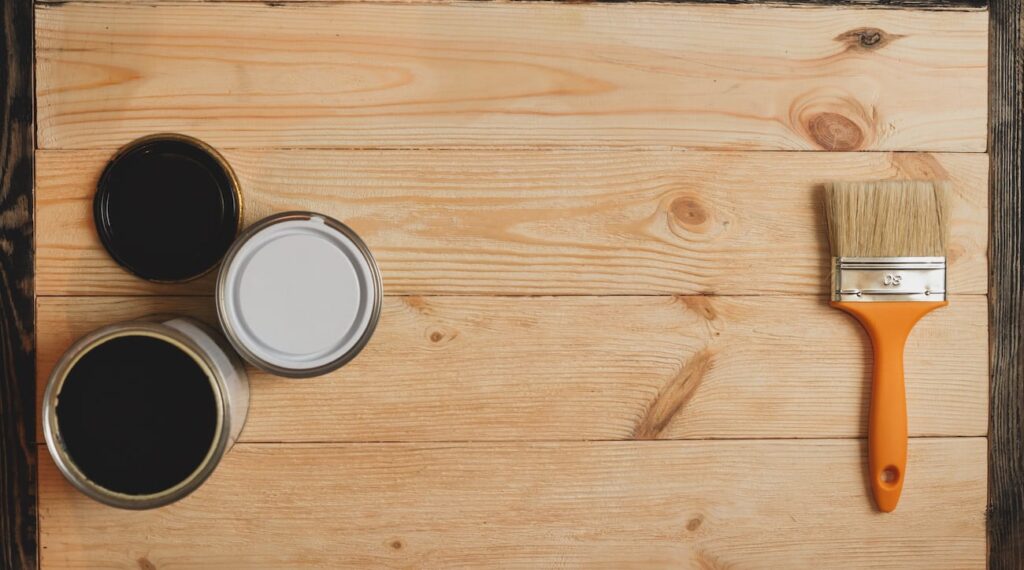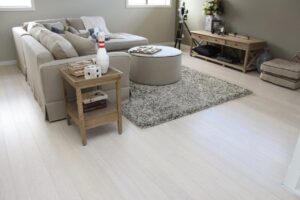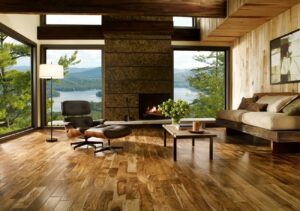Once you finished with the flooring installation, one thing to figure out later is to find the best polyurethane for floors to provide protection and appropriate finish.
In this case, be aware of choosing the quality and type of the flooring finish.
Polyurethane must be well-chosen as the best coating to provide the floors with the great protection against the damage.
There are three layers of finish types to convince the coating longevity and floor protection.
This way, the type and brand of finish you will use for coating the floor are important to determine the coating lifespan.
This time, we are going to review more about the best polyurethane you can consider using for floors including the definition of polyurethane, benefits, types, criteria of the best polyurethane, how to apply it on the floor surface and the tools needed for application as well as the steps on how to do the finishing project.
Maintenance will also be describe in detail along with the polyurethane alternatives.
Now let’s check them all out in the following review sections:
Definition of Polyurethane for Floors
Prior to find the best polyurethane for floors, it would be better to understand what actually a polyurethane for floors is.
Do you know something about to do after installing the floor?
Basically, hardwood floors need to be protected once after being installed.
In this regards, polyurethane is best described to be the most popular option to provide the floors with the protection.
Simply, it is just common to know that polyurethane is the popular option in the world of flooring.
Truly, polyurethane is created to be the protective layer of wood flooring coating. Similar to mats, this layer is a type of the best solution to many flooring problems.
In fact, polyurethane is great especially for hardwood flooring not only because of its strength but also its trustable resistance.
In addition to the wood flooring protection, polyurethane is highly resistant to any types of chemicals and moisture more than the interlocking tiles.
In this case, if you use hardwood floors for wet locations such as laundry room, kitchen and bathroom, using the polyurethane is a very good choice.
Read Also: What Should You Know about the Facts and General Laminate Flooring Cost
Benefits of Using Polyurethane for Floors
There are some big benefits offered by the use of polyurethane for the floors’ coating.
This way, polyurethane is mainly purposed to provide the floors with a great protection against all types of damage.
This means that this protective layer enables the floor to resist the moisture, stains and scratch.
Without polyurethane, the floors will easily get damaged because of the water penetration, moisture and small particles that lead the floors to stain.
Comparatively, polyurethane is not expensive. It can even save your money on floors repairs in a long period.
Further, it will also lengthen the flooring lifespan and durability in a significant way.
It is fairly easy to apply this layer onto the floor without re-applying it too often like many other sealants do.
One more, polyurethane is easy to clean and maintain.
Types of Polyurethane for Floors
In the world of flooring, polyurethane is one of the strongest types of protective layers or coatings.
It is also formulated as a durable varnish to enable the molecules to bond together when they dry.
As one of the best polyurethane for floors, it is strongly resistant to water penetration, solvents and scratches as well as other damages.
Selecting polyurethane probably makes you feel less worried whether to choose the water or oil-based varieties.
Oil-Based Polyurethane
Oil-based polyurethane is a type changing the delicate yellowish-brown color and making a hard film in a few coats.
However, it needs a few minutes more to dry and be toxic due to the fact that it contains volatile organic chemicals.
This polyurethane type also tends to appear in brush marks and nick overtime.
Water-Based Polyurethane
In contrast with oil-based polyurethane, the water-based polyurethane dries quickly and turns to crystal clear.
It requires multiple coats, however, it has a lower volatile organic chemicals. Further, it also cleans up easily using water and soap only.
Many homeowners describe this water-based polyurethane as a great choice due to the easy cleaning feature and short time of applying and drying. Noticeably, water-based polyurethane can be applied very two hours.
In comparison, you need 24 to 48 hours for the oil-based polyurethane to dry. Moreover, this polyurethane type doesn’t emit an odor. The brushes can easily be clean using the water just after the application.
Water-based polyurethane offers the natural wood color so the floor appearance and the project feel will never change. Thus, you don’t have to worry about it.
The Differences Between Oil-Based and Water-Based Polyurethane
There are some significant differences between the oil-based and water-based polyurethane dealing with the appearance, drying time, cost, VOC content and thickness.
Oil-based polyurethane has yellowish-brown color while the water-based is clear.
On oil-based polyurethane needs much longer time to dry while a water-based one only takes two hours. This probably makes the water-based polyurethane expensive.
Truly, the cost of water-based polyurethane is as much as twice the oil-based cost.
The volatile organic chemicals omitted from the water-based polyurethane is higher than that of the oil-based.
Further, an oil-based polyurethane is thicker yet it needs fewer coats to be applied.
Criteria of The Best Polyurethane for Floors
Determining the best polyurethane for floors will never be far away from the criteria that makes the polyurethane best for floors.
In the other words, there are some factors that help you determine whether to choose the oil-based or water-based polyurethane.
Durability
Durability is an important factor you need to check out dealing with how long the polyurethane will last either in its first application or its even use.
Just before purchasing the product, you had better check the dates.
Oil-based is relatively thicker yet it is softer while the water-based polyurethane is an acrylic product, making it thinner but harder coating.
Dealing with the resistance to damage, oil-based polyurethane is more prone to dents while the water-based one is more probe to surface scratching.
Due to the fat that water-based in thinner, applying three coats is much recommended for a minimum coating while the oil-based can apply two coats are minimum already.
If you live with the big pets, applying three coats of oil-based or water-based is considered good to provide the floors with enough protection.
Shine/Sheen
The second best criterion of polyurethane for floors is the shine. In this regards, there are three kinds of shine available in polyurethanes.
Those are the gloss, semi-gloss and satin finishes. Which of the shine you will choose actually depends on your own preference and to what extend you want the floors to shine.
The glossier a polyurethane means the more imperfections and wear overtime because the sheen is only reflecting a light. It acts like a mirror.
It will be more or less shiny depending on the intensity of the sheen level you choose.
What you have to keep in mind is the fact that the sheen level will allow both the light absorption and reflection that hit the floor’s surface.
Typically, more light will be reflected by the semi-gloss polyurethane to make the floors look shiny.
On the contrary, the low gloss or matte finish does more light absorption so that the floors look duller, and not as soft as you expect.
These are the three different effects are much influential to the way the colors contributing to the floor’s look. As a result, the floors will look lighter as well as darker.
Color Impact
The best polyurethane for floors must also fill the criterion that is possessing color impact.
Simply to understand, the color impact will let you to choose whether you want the floors to be shiny or matte. Using the polyurethane finish is actually a chance to have a glossy floor.
In this case, the oil-based polyurethane has an amber color. On the other hand, the water-based polyurethane has a clear color.
Oil-based polyurethane will remain amber, darkening overtime. Meanwhile, the water-based poly will stay clear for the lifetime of the hardwood floors.
In this case, the color differences is less recognizable on the stained hardwood floor, however, the oil-based poly will remain its color and continue darkening over time.
Drying and Curing Time
Looking for the best polyurethane must also consider the drying and curing time.
This way, the water-based poly dries quickly. You can actually place your furniture in few days just after the application.
For home areas with the high traffic floors and heavy furniture, the ultra-fast drying poly is much recommended.
You can walk on the hardwood floors with the water-based poly only 4 to 6 hours. On the contrary, you need 34-48 hours to be able to walk on the water-based ply after the application.
Odor
Odor can be a problem so you must take into consideration.
The water-based poly contains a large amount of volatile organic chemicals, making the poly not good for people with the respiratory sensitiveness.
Thus, you should consider choosing the good brands that comply with the volatile organic chemicals.
Further, you should also consider installing the proper ventilation when you are just applying the polys.
Oil-based polyurethane is noticeably emitting the volatile organic chemicals. The strong bad small will be emitted when the polys are drying up. Thus, doing the application rewires a respirator. Your clothes will also stink for hours.
Hence, you need to go out of the home and bring your pets away while the oil-based poly is once installed.
On the contrary, the water-based ply comes with no smell. In this regards, it is suggested that we apply the poly without using any respirator.
So it won’t stinking the home and will be safe not only for people by also for people.
Price
The best polyurethane for floors will also consider the price.
In this regards, the water-based poly come with the expensive price. A 5 gallon of water-based polys costs $350 while you need only to spy $150 for the oil-based polys. If you are expecting to pay $.50 – $1/sf, you can just buy a water-based polys.
How To Apply The Polyurethane for Floors
Polyurethane is widely known not only for its durability and easy maintenance but also easy way of application.
Truly, it is just pretty easy to apply this protective wood finishes. As we have mentioned above, polyurethane comes in two types that are the water-based polys and the oil-based polys.
These two types of polys has only a minor difference both in application and in performance.
In this regards, the standard polyurethane is applied using brush, rag, and spray in aerosol cans. No matter which types of polys you are going to use, wear and tear will always visible.
Thus, consider the following steps in applying the polyurethane to minimize the wear and tear.
Step 1: Wood Prepping
Good finishes will basically depend on the smooth and clean surface. This way, the hardwood floors must be sanded with 220-grit sandpaper.
Of you have open-grain wood floors, you need to apply a wood grain filler before applying the polyurethane. This is aimed to create a smooth surface.
Make sure the hardwood floors are clean to remove the dust after the sanding process and apply each coat of polyurethane.
You can use a vacuum or a tack cloth as well as rag moistened along with the mineral spirit.
Alternatively, you can also use the cheesecloth moistened along with the denatured alcohol.
Step 2: Oil-Based Polys Application
Always check the manufacturer’s recommendation whether you need to use the mineral spirit or not. In this case, you don’t even need to use it to apply the oil-based polys.
In this case, thinning can help the flow of the finish. Just apply the oil-based poly suing the fine bristled brush or a foam brush.
Avoid using a cheap brush since it can leave a clear brush stroke. In this regards, foam brushes are cheap but they work well especially for most of the flat surface.
Bristle brushes is considered better for molded edges and fine details. So just brush the polys to the grain of the wood.
In this case, the polys can sand easily so you must be careful in doing it. Don’t go too far since you can sand the thin coat and damage the stain.
Remove all the dust using vacuum and tack cloth before applying the second coat.
Step 3: Water-Based Polys Application
Rough up the stained surface slightly before you apply this water-based polys using the synthetic steel wool.
Actually, the application of water-based polys and oil-based polys is similar.
You can apply the polys using a fine brush and work with the grain. Let it dry and remove the dust before you do the next coating.
Read Also: Applying All Natural Linoleum for Basement Floors
How To Clean and Maintain Polyurethane Floors
Once you are done with the polyurethane application, it is the time to check out how to clean and maintain the floors with polyurethane.
This way, there are two basic ways of maintenance that are damp mopping and restore dull finish.
Damp Mopping
Since moisture is the major issues on wood flooring, you must make sure that there is no water standing on it.
To avoid the water penetration, use vinegar mix to cut through the mineral streaks. Add about ¼ cup or ½ cup of the vinegar to the dish soap cleaning solution.
This is considered a good treatment for damp mopping the floors with the polyurethane.
Restoring Dull Finish
Simple cleaning is always needed to restore the dull finish on the polys floors. You can perform this cleaning action by wiping on the finish restoring product.
Screening the floor is also a good idea to scuff the floor with a floor buffer and a sanding disk.
Remember, one-day-application which is called screening and re-coating will be able to add a life span to an existing wood floors finish. There are more years to come offered.
Polyurethane for Floors Alternative
Dealing with the best polyurethane for floors, there are some polyurethane alternatives to consider.
In this case, the thinness is the major benefit of wipe-on and spray polyurethane. Both of them can be best applied in ultra-thin coats to result the less buildup in nooks and crannies.
Wipe-on polyurethane is applied with a clean lint-free rag while the spray poly use only the spray paint.
Some wood workers like using the spray poly for the thin coat on the base coats of conventional poly. This is aimed to produce the smoothness of the poly coating.
Both wipe-on and spray poly are good solutions for a tricky application along with the fine details and vertical surfaces.
Noticeably, the light application will reduce the drips and buildup. The primary downside of this thinner formulas is the fact that you seem needing more coats for a good protective layer.
This way, 4 to 5 coats are considered good instead of 2 to 3 coats using the conventional brush-on polyurethane.





